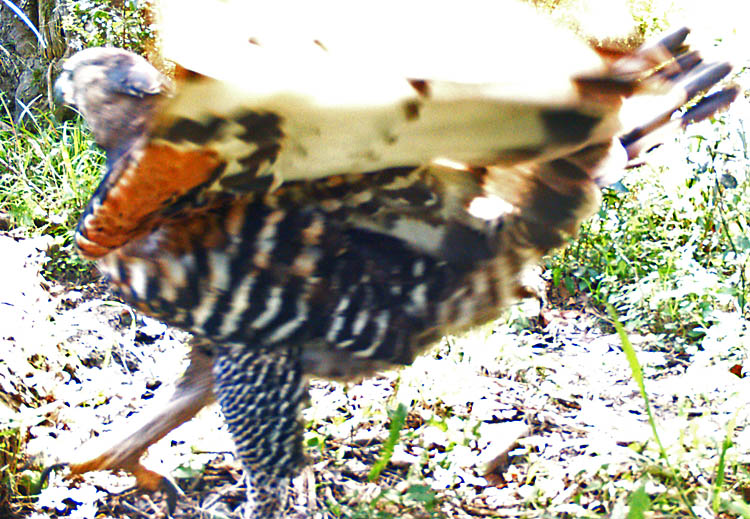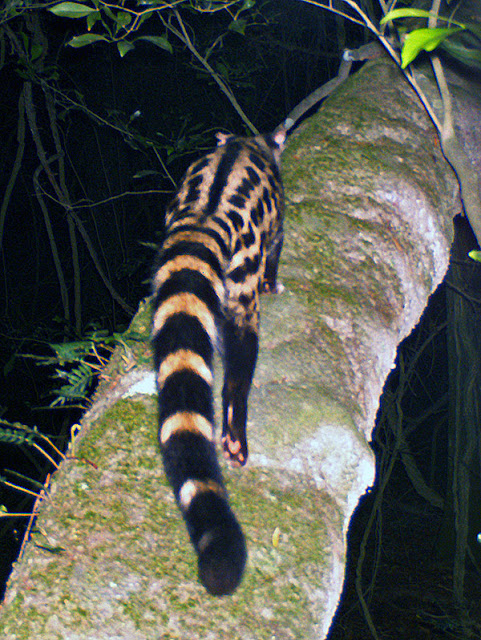There is plenty of meat available for a hungry predator at the Woody Cape in the form of Bushbuck, Bush Pig, Vervet Monkeys, Blue Duiker, etc. So where are the predators?
The most common carnivores camera trapped thus far have been the diurnal Small Grey Mongoose and nocturnal Large-Spotted Genet (see a previous entry
over here). However, these little predators specialise on killing smaller animals such as rodents, bird and insects.
Luckily my most recent set of photographs from the Woody Cape contained some interesting finds. My old Cuddeback captured a distressed young Bushbuck running past the camera.
 |
| A young Bushbuck (Bosbok - Tragelaphus sylvaticus) making a run for it |
The Cuddeback might take pretty photographs at night, but unfortunately it takes 30 seconds to recover, however that was just enough time to catch the tail of a Honey Badger zipping past the camera.
 |
| Honey Badger (Ratel - Mellivora
capensis) in pursuit of the Bushbuck? |
What makes these images interesting is that Honey Badger usually pray on small animals such as rodents and insects, but they are also know to take reptiles, birds, fruit and other small mammals, including small antelope. These guys are notoriously tough and I'm sure one can take down a small Bushbuck if it really wants to.
The Honey Badger isn't a new species to my camera trapping list at the Woody Cape, I regularly get images of them passing by (see a previous entry
over here).
I don't see a Honey Badger as a primary predator of the larger mammal species. So, what other predators are still around in the Woody Cape?
Recently SANParks released a news headline that a Brown Hyena was camera trapped in the Colchester section of the park (story
over here). I must admit that I'm a little envious :) The Colchester section is approximately 60km away from the Woody Cape section where I'm busy camera trapping. It has a different habitat and is on the other end of the protected coastline forming part of the Addo Elephant National Park.
Now, the Brown Hyena might be a large carnivore, but it is not really a predator, it is predominantly a scavenger and it is very seldom that it kills it's own food.
But last month I finally got a photograph of a real predator. One with the reputation to back it up and a familiar face for any long time readers of this blog.
 |
| A Caracal (Rooikat - Caracal
caracal) in the Woody Cape, seemingly on a mission (as always...) |
Caracal might prefer to hunt small to medium sized animals, but as any sheep farmer will tell you they are very capable in killing much larger animals as well. I'm sure that they will not think twice about having a young Bushbuck for a meal. They might even take on the odd adult, but since Bushbuck don't have a fixed breeding season there should be a constant supply of youngsters to pick from.
I've been hoping for a Caracal since day one, but I must admit that I was very surprised to finally get a picture of one at this location. This camera was a last minute setup and I had low expectations of it.
But this location had one more predator to reveal.
 |
| African Crowned Eagle (Kroonarend - Stephanoaetus coronatus) striking down |
The
African Crowned Eagle might not be the biggest eagle on the continent (the Verreauxs' Eagle and Martial Eagle are bigger), but it is considered to be the most powerful.
It is a specialist mammal hunter and has been known to kill adult Bushbuck, weighing over six times it's own weight! They have short but broad wings and a long tail to allow them to hunt in the forests and thickets of Africa. They prey mainly on monkeys, dassies and antelope throughout their range. They are even rumoured to kill human children.
The African Crowned Eagle usually hunts by waiting in the canopy for an animal to pass by and then swoops down onto it, crushing it with its powerful talons, easily puncturing vital organs/bones/scull with its 10cm long talons. They will sneak up on their prey if it doesn't move their way, moving through the vegetation into strike range.
The African Crowned Eagle has been listed as Near Threatened in recent years and it is good to see them around in the Woody Cape.
With the predators starting to show themselves I find my hopes rekindles for the elusive Woody Cape Leopard, and I'm still waiting for those Black-Backed Jackal I've seen in the neighbouring cattle farms to venture into the forest. Or maybe I'll find a Brown Hyena in the Woody Cape's coastal dunes when I get around to camera trapping there? Time will tell.











